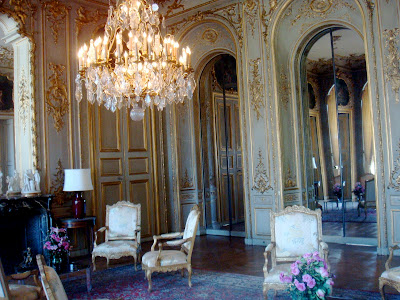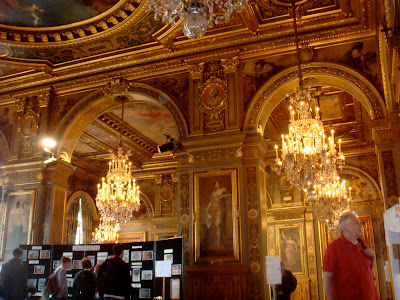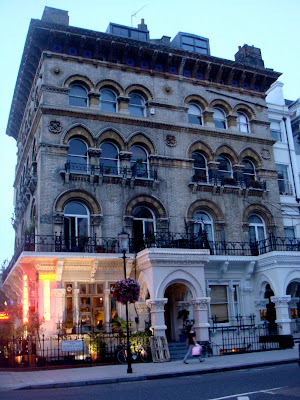My weekend of peeking into beautiful buildings of Paris which are typically closed to the public continued with a glimpse into three embassy buildings. All historical buildings with their own stories, they come alive in this century with the festivities that go along with embassy life. The first I visited was l'Hôtel de Charost, currently the residence of the British ambassador, located on the rue du Faubourg Saint-Honoré.
Built between 1722-25 for the duc de Charost, it was later sold to Pauline Leclerc, the sister of Napoleon.
Seen here is the Salon Pauline with her bed. When Napoleon's empire was established, Pauline became an imperial princess and her home was the center of a small court who attended to her.
In 1814, the Duke of Wellington was the newly appointed British ambassador to France, and he purchased the home and all its contents from Pauline to be the new embassy building for his country. The throne room is still used for investiture ceremonies.
Queen Victoria still oversees the activities there.
Dinner was set for 60 guests in the dining room decorated in the Louis XVI style. The table is 15 meters long with 28 leaves, and one single linen cloth made in Northern Ireland covers the length of the table. Wouldn't you just hate to be the guest to spill a drop of wine on that??
The grounds behind the house are expansive, stretching all the way to a back gate to the Champs Elysées which Napoleon would use to access the property.
Next we stood in a short line to visit l'Hôtel de la Rochefoucauld-Doudeauville, the embassy of Italy. Located along the rue de Varenne with many other 18th century hôtels particuliers, the Italian Embassy acquired it in 1937. The best translation for hôtel particulier is a grand, private, usually free standing house, which is located between the entrance court at the street and a back garden. Seen here is the front entrance, behind which is a courtyard where the carriages could pull in and unload, and then the house would be behind the courtyard.
Once again, the interior was dazzling,
with many rooms decorated in the Louis XV style. Beautiful!
The Théatre Sicilien was unique. This 18th century theater was transported from the Palais Butera de Palerme in Sicily and installed in this location in the early 20th century. Do you think they might could use someone on staff to straighten the candles? Why do little things like that drive me crazy!!
Behind the house are the beautiful gardens, perfect for strolling.
We also had time to see l'Hôtel d'Estrées, nearby on the rue de Grenelle, which is the home of the Ambassador of Russia. You get a feel here of standing in the courtyard after you have entered through the street entrance.
so that you would tour the exhibit and then step back and take in the grandeur of the rooms. Having been to Russia in the spring, I found the exhibit fascinating, as well as the website advertising it with its photos of the Russian embassy.
Lunch was ready to be served,
as well as tea.
And every "proper" hôtel particulier had its lovely garden for entertaining and enjoying.
Here's a souvenir I really wanted to take home with me for my princess of a granddaughter-- a tiara created in 1911 by Cartier, in the style of a diadème kokochnik, a popular Russian style. Not for sale in the gift shop at the end of the tour though--too bad.
Believe it or not, there are more buildings to come in my next post--so many open doors. Hope you'll come back for the tour.





























































































